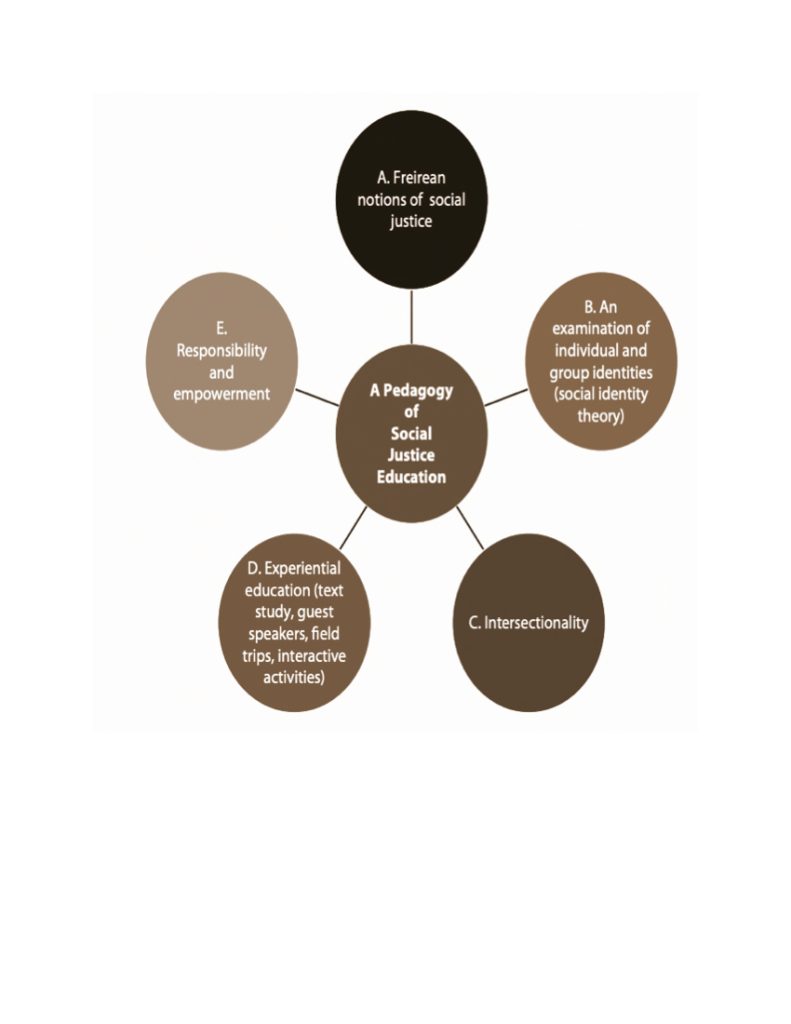The article by Hahn Tappers on social justice education is written sagaciously; it articulates the difference between the social justice theory by Henri Tajfel (1979) et al. and Freires’ ideas on the same concept.
Tapper enunciates social justice in education as one of the constructions of social justice education that speaks of ‘the disparities in societal opportunities, resources, and long-term outcomes among marginalised groups (Shakman et al., 2007)’. Similarly, Tapper refers to it as ‘anti-oppression education’, ‘diversity education’ and ‘multicultural education.’

The pedagogy structure sits on three educational pillars:
● Freire’s proposition for education and social justice
● Social identity theory
● Intersectionality
Freire (2006) argues that education is the key to legislating social justice. Tapper further postulates that Friere considers education is the key to intellectual and physical freedom. Allowing students’ identities to filter in an educational setting is paramount for the development and inclusion of all students. Friere and this article argue that education settings and teaching fail when the banking system is utilised. In return, this introduces the teacher as a dominant figure in the hierarchy system. Thus, and so forth, depositary teaching fails the student as their personal and social identity is invalidated. Democratised learning allows candide learning as it factors experiential, cultural, personal and social exploration rather than depository, dictatorial and dominant ideals and approaches that of the teacher’s social identity. (Rozas, 2007)
Robust teaching and learning methods come when students co-create their educational process with their educators (Freire, 2006).
I employed Freire’s and Tajfel’s teaching concepts before understanding the concepts of social identity theory. My classrooms are culturally and ethnically rich. Therefore, intercultural competency is essential for the students to be aware and create empathy for each other and learn from one another despite their differences – race, ethnicity, gender, class, sexual orientation, physical disabilities and socioeconomic structure. (Banks, 1991; Chang, 2002; Lawson, Komar, & Rose, 1998; Sleeter & Grant, 1994). Challenging and facilitating the students to think critically and more deeply about their assumptions is vital. My role as a tutor is for the students to recognise, accept and celebrate their differences in an inclusive and supportive manner.
References
Banks, J.A. (2020). Diversity, Transformative Knowledge, and Civic Education. Routledge.
Edwards, C. & Harwood, J. (2003). Social Identity in the Classroom: An Examination of Age Identification Between Students and Instructors. Communication Education, 52(1), 60–65. doi https://doi.org/10.1080/03634520302463.
Freire, P. (1970). Pedagogy of the oppressed. New York: Bloomsbury Academic.
Iseminger, S., Acheson-Clair, K., Kelly, C. & Morris, P. (2020). The Effects of Social Identities on Student Learning Outcome Attainment. International Journal for the Scholarship of Teaching and Learning, 14(1). doi https://doi.org/10.20429/ijsotl.2020.140112.
Hahn Tapper, A.J. (2013). A Pedagogy of Social Justice Education: Social Identity Theory, Intersectionality, and Empowerment. Conflict Resolution Quarterly, 30(4), pp.411–417. doi https://doi.org/10.1002/crq.21072.
PSYCHOLOGY WIZARD. (n.d.). Social Identity Theory AO1 AO2 AO3. [online] Available at:https://www.psychologywizard.net/social-identity-theory-ao1-ao2-ao3.html.
Tajfel, H. (1974). Social identity and intergroup behaviour. Social Science Information, 13(2), 65–93. doi https://doi.org/10.1177/053901847401300204.
Tajfel, H., Turner, J. C., Austin, W. G., & Worchel, S. (1979). An integrative theory of intergroup conflict. Organisational identity: A reader, 56-65